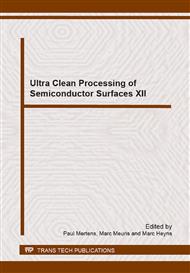p.165
p.170
p.177
p.183
p.187
p.193
p.197
p.201
p.205
Megasonic Enhanced Photoresist Strip with DiO3
Abstract:
Twenty years ago dissolved ozone in DIW (DiO3) found its way into the semiconductor industry as a cleaning agent. DiO3 provides an effective replacement for Piranha (H2SO4, H2O2) cleans. The fundamental chemistry of ozone based cleaning is due to direct and indirect reactions of ozone and oxygen radicals (the so-called radical pathway). Due to its high oxidation rate the radical pathway can accelerate the reaction. Megasonic energy can act as an initiator for the radical pathway. At the same time, due to the creation of turbulence inside the boundary layer, the available ozone close to the surface is increased. In the present study this chemical physical combination was tested for improvement of photoresist strip rate.
Info:
Periodical:
Pages:
187-190
Citation:
Online since:
September 2014
Authors:
Keywords:
Price:
Сopyright:
© 2015 Trans Tech Publications Ltd. All Rights Reserved
Share:
Citation:


